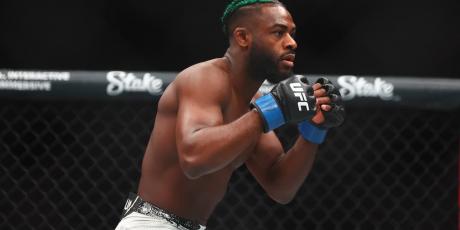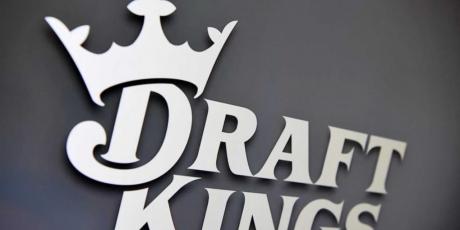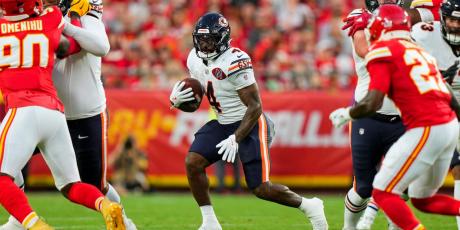NFL Teams to Attack & Avoid in Best-Ball Drafts

Riding the coattails of a great offense seems a surefire way to propel your best-ball teams to their fair share of championships. That’s the theory, anyway.
Today’s best-ball broad-stroke theory article is going to be a top-down view of how NFL teams as a whole impact our year-end point totals. While we will end up touching on stacking throughout, individual stacks to build your 2020 lineups around will be broached at a more granular level on a future date. Instead, we will be probing through 2019 results to find out whether or not a team’s offensive landscape can be the tide that lifts all boats or if separating a player from the team he plays for is a better strategy while filling our best-ball rosters.
Looking Back to Look Forward
Before moving on to the practical information to be applied for current and future best-ball drafts, it’s important to look back at 2019’s numbers to see what we can infer about the information.
Highest Scoring NFL Teams
We’ll start with the good news. Below we have the seven highest-scoring teams by fantasy points in 2019. Teams are listed in descending order, with the three corresponding players drafted with the highest average draft position.
Both ADP and scoring are from FFPC best-ball drafts and include scoring from the quarterback, running back, wide receiver and tight end positions. You’ll notice some tight ends with higher-than-expected ADPs due to FFPC scoring being TE Premium. The Average Points/Wk column adds up all scoring from that specific team and doesn’t necessarily take into account whether that player(s) would have been in a starting lineup.
| Team | Average Points/Wk | First (ADP) | Second (ADP) | Third (ADP) |
|---|---|---|---|---|
| Cowboys | 127.5 | Ezekiel Elliott (1.4) | Amari Cooper (3.09) | Dak Prescott (9.09) |
| Buccaneers | 122.5 | Mike Evans (2.11) | O.J. Howard (4.09) | Chris Godwin (5.04) |
| Ravens | 115.6 | Mark Ingram (4.12) | Lamar Jackson (9.03) | Mark Andrews (9.07) |
| Chiefs | 115 | Travis Kelce (1.06) | Damien Williams (3.03) | Patrick Mahomes (3.07) |
| Rams | 113.3 | Todd Gurley (2.03) | Brandin Cooks (4.08) | Robert Woods (5.01) |
| Eagles | 113 | Zach Ertz (2.07) | Alshon Jeffery (7.02) | Miles Sanders (7.10) |
| Chargers | 112.5 | Melvin Gordon (2.08) | Keenan Allen (3.04) | Hunter Henry (4.11) |
Not too many surprises at the top of the ladder here, as these teams are widely regarded as some of the most efficient offenses in the league. Six of the seven teams finished 2019 with an above-average pass-to-run ratio in neutral game scripts (within one score, whether ahead or behind), with the one exception being the Baltimore Ravens who currently feature the best rushing attack in the league.
The heavy passing teams leading the charge in accumulating fantasy points should be intuitive; not only is passing the ball more efficient in today’s league, but it also incorporates two people on every play. If Amari Cooper catches a touchdown, it’s worth at least six points for him and six points for his quarterback, as opposed to the one-sided scoring output of an Ezekiel Elliot goalline plunge for a score.
I’d like to touch on the Baltimore Ravens for a moment before we dig into the most frustrating teams to own shares of fantasy commodities. In more ways than one, the Ravens had an outlier of a year in terms of “real” football and fantasy football. After a disappointing ousting by the hands of the Chargers in the 2018 playoffs, no one was expecting the type of year Lamar Jackson was about to have. Jackson’s 36:6 touchdown-to-interception ratio was masked by his 1,206 yards rushing, creating one of the most reliable fantasy floors we have ever seen. He was accompanied by teammates Mark Ingram (4.12 ADP) and Mark Andrews (9.07) far outpacing their respective ADPs. While every other team on this list were pass-happy offenses with pieces that cost premium draft capital, the Ravens were a team that had shown glimpses of their upside in the second half of 2018 but were still available at or near their floor in 2019 drafts.
Lowest Scoring Teams
On the flip side of those fantasy behemoths, are the basement-dwelling, bottom-rung of fantasy contribution. Intermixed with teams that most of us were pretty certain to be terrible producers, other teams shocked us with a lack of output, either suddenly bereft of a quarterback or never quite clicking as a cohesive offense.
| Team | Average Points/Wk | First (ADP) | Second (ADP) | Third (ADP) |
|---|---|---|---|---|
| Redskins | 60.6 | Derrius Guice (6.05) | Jordan Reed (11.06) | Adrian Peterson (14.10) |
| Jaguars | 61.2 | Leonard Fournette (3.04) | Dede Westbrook (10.03) | Nick Foles (14.08) |
| Steelers | 62.9 | James Conner (2.01) | JuJu Smith-Schuster (2.03) | Vance McDonald (7.01) |
| Colts | 65.1 | Marlon Mack (3.09) | T.Y. Hilton (3.10) | Eric Ebron (6.09) |
| Bears | 66.9 | David Montgomery (5.05) | Tarik Cohen (5.08) | Allen Robinson (6.07) |
| Dolphins | 69.1 | Kalen Ballage (12.08) | Mike Gesicki (16.06) | DeVante Parker (19.04) |
| Jets | 69.7 | LeVeon Bell (1.10) | Robby Anderson (7.09) | Chris Herndon (10.12) |
If the Baltimore Ravens had the most surprisingly positive fantasy season then it stands to reason that their division-mate Steelers had the most surprisingly negative fantasy season in 2019. Just two games into the season, Ben Roethlisberger was forced to have surgery on his throwing elbow, leaving the rest of the season up to Mason Rudolph and Devlin Hodges. The offense as a whole struggled immensely while each of the three quarterbacks finished in the bottom third of the league in yards per attempt (minimum 50 pass attempts). When he was able to find the field, James Conner was relatively ineffective and his disappointing injury-riddled season may cost him his perch atop the depth chart moving forward. All-in-all, shares of the Pittsburgh Steelers in best-ball were a sunk cost.
Inversely of the top-scoring teams, five of the seven lowest scoring teams had a neutral game script pass-to-rush ratio at or below league average. With so many of these teams willing to plod the ball up and down the field until they were multiple scores down, it didn’t create environments for usable fantasy production. While some of the teams had legitimate issues at quarterback and had to pivot in-season or directly before the season (Steelers - Roethlisberger, Colts - Andrew Luck and Jaguars - Nick Foles), the rest of these teams stubbornly ran the ball into the ground, shortening the game and eradicating touchdown opportunities. Unsurprisingly, six of these seven teams were also at or below league average in neutral game script pace of play.
How to Apply this Information in 2020
I wish I could send you on your way with a nice and easy bit of advice such as, “make sure you draft players on teams that will score a lot of fantasy points”, or reciprocally, “avoid players on teams that will score few fantasy points”. Alas, you wouldn’t be making it a point to read fantasy football articles if you didn’t already understand that information. Instead, let’s try to apply some of the things we have learned from the previous sections and see if we can unturn some rocks for morsels of information that other drafters may not be considering.
Teams and Players to Target at ADP
Knowing what we now know —teams with the highest fantasy output also tend to rely heavily on the pass in neutral game scripts— let us take a look at the pass-heaviest teams while in neutral game script over the last three seasons and see if there are any current values at ADP for those teams.
| Team | Three Year Avg Pass Rate | First (ADP*) | Second (ADP) | Third (ADP) |
|---|---|---|---|---|
| Chiefs | 64% | Travis Kelce (1.09) | Tyreek Hill (2.04) | Patrick Mahomes (3.05) |
| Chargers | 61% | Austin Ekeler (2.04) | Keenan Allen (5.02) | Hunter Henry (4.10) |
| Falcons | 61% | Julio Jones (2.08) | Todd Gurley (3.05) | Calvin Ridley (5.02) |
| Bengals | 61% | Joe Mixon (1.10) | Tyler Boyd (7.09) | A.J. Green (7.11) |
| Steelers | 61% | JuJu Smith-Schuster (4.07) | James Conner (4.08) | Eric Ebron (11.02) |
| Packers | 60% | Aaron Jones (1.12) | Davante Adams (2.04) | Aaron Rodgers (9.04) |
| Giants | 60% | Saquon Barkley (1.03) | Evan Engram (5.12) | Daniel Jones (9.11) |
*FFPC best-ball ADP
As can be expected, the offensive pieces of the Super Bowl-winning Kansas City Chiefs are incredibly expensive, and if you’re looking for a value-saving commodity from their team you’re going to have to go all the way down to Demarcus Robinson or Sammy Watkins. This exercise does produce some intriguing price points, particularly with the Pittsburgh Steelers and the New York Giants. The bounceback in Pittsburgh relies entirely on the shoulders of a healthy Ben Roethlisberger, and besides that, Eric Ebron's price is climbing, and will continue to climb until the preseason. Let’s instead pinpoint what is going on in New York, where every wide receiver is going in double-digit rounds.
Darius Slayton (11.04), Sterling Shepard (13.11) and Golden Tate (15.10) are each leaving the board well after ball hogs Saquon Barkley (1.03) and Evan Engram (5.12), which leaves us with an opportunity to acquire the later pieces if we miss out on the studs. As it stands today, it is not a likely scenario that the Giants add to these offensive pieces in the upcoming NFL Draft, as they have more pressing needs at offensive tackle and the entirety of their defense. With new offensive coordinator Jason Garrett, we shouldn’t see much of an offensive makeover, especially as it pertains to usage in the passing game. The pass distribution in 2019 was eerily similar in both the Cowboys and Giants offenses.
| Team | Targets | RB Tgt % | WR Tgt % | TE Tgt % |
|---|---|---|---|---|
| Cowboys | 583 | 16.6% | 60.9% | 22.5% |
| Giants | 584 | 17.1% | 59.2% | 23.6% |
There is a chance one (or two) of Slayton, Shepard or Tate finish the season with 100+ targets, and that is well worth a speculative add at that cost. If you’d prefer to buy the syrup instead of the pancakes, Daniel Jones is currently the QB12 according to ADP. He is likely to creep up boards if the Giants do pay a premium for an offensive tackle in the first round.
Teams and Players to Avoid at ADP
On the flip side of those pass-heavy teams we want to load up on due to their yardage efficiency and scoring prowess, there are the teams we should be trying to avoid at cost. The teams that are prone to draining the clock and keeping the scoring output relatively low. The Kliff Kingsbury antithesis, if you will.
| Team | Three Year Avg Neutral Pace (seconds) | First (ADP) | Second (ADP) | Third (ADP) |
|---|---|---|---|---|
| Redskins | 32.39 | Terry McLaurin (6.12) | Derrius Guice (7.04) | Adrian Peterson (18.10) |
| Bears | 32.38 | Allen Robinson (4.07) | David Montgomery (5.06) | Tarik Cohen (10.04) |
| Raiders | 32.12 | Josh Jacobs (2.02) | Darren Waller (4.07) | Hunter Renfrow (14.11) |
| Jaguars | 31.7 | Leonard Fournette (2.09) | D.J. Chark (6.07) | Gardner Minshew (14.05) |
| Dolphins | 31.67 | DeVante Parker (6.09) | Mike Gesicki (8.02) | Jordan Howard (10.05) |
| Titans | 31.63 | Derrick Henry (1.08) | A.J. Brown (4.05) | Jonnu Smith (9.12) |
| Chargers | 31.61 | Austin Ekeler (2.04) | Keenan Allen (5.02) | Hunter Henry (5.10) |
The Chargers are the only team to appear in both lists which makes a lot of sense after operating as the slowest team in the league last season while finishing the season in second place (behind the Vikings) with a running back touch percentage of 64.2%. They employed their offense through Austin Ekeler and Melvin Gordon as often as they could, both through the air and on the ground.
This information does give me further pause on players like Terry McLaurin, Allen Robinson, D.J. Chark and DeVante Parker. I'm not saying to avoid these players altogether, but if they’re not going to be seeing the type of volume as players on pass-heavy teams then I would beware of overloading your portfolio on them. They just aren’t likely to have the scoring environment we’re hoping for on our best-ball teams.
Leonard Fournette became a large part of the Jacksonville passing attack and has seen his ADP jump a round from last season but he is likely to be in the same boat as second-rounder Josh Jacobs; is the offensive environment likely to allow either to finish as a top-eight running back? They both sit on two of the slowest moving teams in the league, and there isn’t a 16-game season out of this duo’s first four combined years in the league.
Bottom Line
There is never a scenario in which we can carbon copy one season into another. That said, we need to consider as much historical data as possible and taking both extreme spectrums of pass-to-rush ratio and neutral game pace gives us an idea of teams’ offensive philosophy. To wrap it up in a sweet bow; teams that lean on the pass —even when they’re not behind— are going to create positive fantasy scoring environments. Even for their running backs.






















